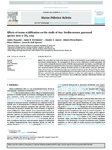Effects of ocean acidification on the shells of four Mediterranean gastropod species near a CO 2 seep
| dc.contributor.author | Duquette, A | |
| dc.contributor.author | McClintock, JB | |
| dc.contributor.author | Amsler, CD | |
| dc.contributor.author | Pérez-Huerta, A | |
| dc.contributor.author | Milazzo, M | |
| dc.contributor.author | Hall-Spencer, JM | |
| dc.date.accessioned | 2017-10-13T09:33:07Z | |
| dc.date.available | 2017-10-13T09:33:07Z | |
| dc.date.issued | 2017-08-18 | |
| dc.identifier.issn | 0025-326X | |
| dc.identifier.issn | 1879-3363 | |
| dc.identifier.uri | http://hdl.handle.net/10026.1/10056 | |
| dc.description.abstract |
Marine CO2 seeps allow the study of the long-term effects of elevated pCO2 (ocean acidification) on marine invertebrate biomineralization. We investigated the effects of ocean acidification on shell composition and structure in four ecologically important species of Mediterranean gastropods (two limpets, a top-shell snail, and a whelk). Individuals were sampled from three sites near a volcanic CO2 seep off Vulcano Island, Italy. The three sites represented ambient (8.15pH), moderate (8.03pH) and low (7.73pH) seawater mean pH. Shell mineralogy, microstructure, and mechanical strength were examined in all four species. We found that the calcite/aragonite ratio could vary and increased significantly with reduced pH in shells of one of the two limpet species. Moreover, each of the four gastropods displayed reductions in either inner shell toughness or elasticity at the Low pH site. These results suggest that near-future ocean acidification could alter shell biomineralization and structure in these common gastropods. | |
| dc.format.extent | 917-928 | |
| dc.format.medium | Print-Electronic | |
| dc.language | en | |
| dc.language.iso | en | |
| dc.publisher | Elsevier | |
| dc.subject | CO2 seep | |
| dc.subject | Ocean acidification | |
| dc.subject | Gastropods | |
| dc.subject | Shell | |
| dc.subject | Mineral | |
| dc.subject | Mediterranean | |
| dc.title | Effects of ocean acidification on the shells of four Mediterranean gastropod species near a CO 2 seep | |
| dc.type | journal-article | |
| dc.type | Article | |
| dc.type | Proceedings Paper | |
| plymouth.author-url | https://www.ncbi.nlm.nih.gov/pubmed/28823551 | |
| plymouth.issue | 2 | |
| plymouth.volume | 124 | |
| plymouth.publication-status | Published | |
| plymouth.journal | Marine Pollution Bulletin | |
| dc.identifier.doi | 10.1016/j.marpolbul.2017.08.007 | |
| plymouth.organisational-group | /Plymouth | |
| plymouth.organisational-group | /Plymouth/Faculty of Science and Engineering | |
| plymouth.organisational-group | /Plymouth/Faculty of Science and Engineering/School of Biological and Marine Sciences | |
| plymouth.organisational-group | /Plymouth/PRIMaRE Publications | |
| plymouth.organisational-group | /Plymouth/REF 2021 Researchers by UoA | |
| plymouth.organisational-group | /Plymouth/REF 2021 Researchers by UoA/UoA07 Earth Systems and Environmental Sciences | |
| plymouth.organisational-group | /Plymouth/Research Groups | |
| plymouth.organisational-group | /Plymouth/Research Groups/Marine Institute | |
| plymouth.organisational-group | /Plymouth/Users by role | |
| plymouth.organisational-group | /Plymouth/Users by role/Academics | |
| dc.publisher.place | England | |
| dcterms.dateAccepted | 2017-08-04 | |
| dc.rights.embargodate | 2018-8-18 | |
| dc.identifier.eissn | 1879-3363 | |
| dc.rights.embargoperiod | Not known | |
| rioxxterms.versionofrecord | 10.1016/j.marpolbul.2017.08.007 | |
| rioxxterms.licenseref.uri | http://www.rioxx.net/licenses/all-rights-reserved | |
| rioxxterms.licenseref.startdate | 2017-08-18 | |
| rioxxterms.type | Journal Article/Review |


